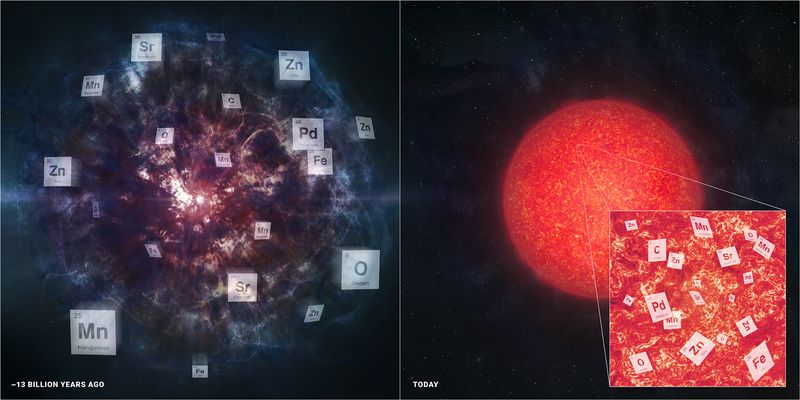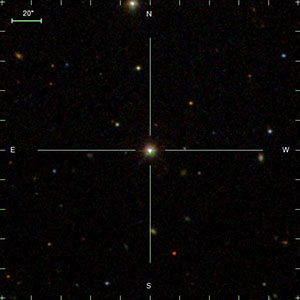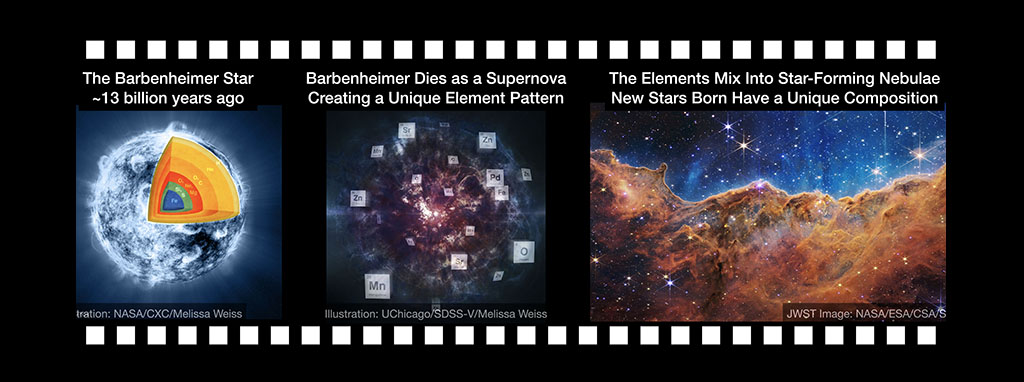Astronomy’s new blockbuster is now playing in New Orleans. Astronomers from the Sloan Digital Sky Survey (SDSS) have discovered evidence for what they call the “Barbenheimer Star” – an enormous ancient star that exploded in a way previously thought impossible, resulting in an unusual pattern of elemental ashes that left behind a trail of evidence still visible billions of years later.

1) The “Barbenheimer Star,” a highly unusual star at least 50 times the mass of the Sun
2) The star dies in a supernova explosion, releasing the new elements it created during its lifetime
3) Those elements mix together into clouds of gas
4) New stars form out of the gas clouds, including J0931+0038
5) A star cluster further changes the chemical composition of J0931+0038
6) The SDSS notices that J0931+0038 is unusual and flags it for further observation
7) Astronomers take more spectra and reconstruct the scene
Image and illustration credits: NASA, ESA, CSA, StSci, University of Chicago, SDSS-V, S5, Melissa Weiss, James Josephides, Yuri Beletsky
DOWNLOAD IMAGE
This version (840 x 360 pixels, 179 kB)
With numbers instead of in-image captions (840 x 630 pixels, 150 kB)
Full-size, with in-image captions (27.3″ x 20.5″, 300 dpi, 4.4 MB)
Full-size, with numbers (27.3″ x 20.5″, 300 dpi, 4.0 MB)
“We’ve never seen anything like this,” says Alex Ji of the University of Chicago and SDSS, the lead author of the study. “Whatever happened back then, it must have been amazing. We nicknamed it the ‘Barbenheimer Star’ for its spectacular nucleosynthesis.”
Ji and colleagues didn’t see the Barbenheimer Star directly. Instead, they followed the trail back in time using a process called “stellar archaeology.” Just as archaeologists use evidence found in the present to reconstruct the past, astronomers use evidence found in today’s stars to reconstruct conditions in the ancient universe. Today’s stars are like chemical time capsules: they preserve what a piece of the universe was like when the star was born.
The trail of evidence began with a star that, at first glance, appears unremarkable. The star, called J0931+0038, is a distant, bright red star captured in an SDSS image way back in 1999. Twenty years later, the SDSS telescope turned once again to the star – this time in technicolor. The SDSS Milky Way Mapper program observed the star’s spectrum, which measures how much light the star gives off at different wavelengths. A spectrum can reveal many things about a star, such as its temperature and chemical composition – and it was chemistry that first led Ji and his team of stellar archaeologists to notice J0931+0038.

Right: Today, we can look at J0931+0038 to see that unusual mix of elements and reconstruct the history of the Barbenheimer Star.
Image credit: University of Chicago/SDSS-V/Melissa Weiss
DOWNLOAD IMAGE
This version (840 x 421 pixels, 584 kB)
Full-size (5.4″ x 2.7″, 300 dpi)
Stars are mostly made of hydrogen and helium, but they also incorporate some of the heavier elements, which were created in previous generations of stars and released into the universe in supernova explosions. These heavier elements show up as prominent valleys in a star’s spectrum. The SDSS spectrum indicated that J0931+0038 had an unusually low amount of magnesium, prompting further followup from the Magellan telescopes in Chile. When Ji and colleagues first viewed the followup spectrum of J0931+0038, they were amazed.

Image Credit: Jordan Raddick and the SDSS-V collaboration
DOWNLOAD IMAGE
This version
(300 x 300 pixels, 30 kB)
“As soon as I saw the spectrum, I immediately emailed the rest of the team to talk about how to learn more,” Ji said.
Several things made the star different from other stars: low abundances of elements with odd numbers on the periodic table like sodium and aluminum; a large amount of elements close to iron in the periodic table like nickel and zinc; and an overabundance of heavier elements like strontium and palladium.
“We sometimes see one of these features at a time, but we’ve never before seen all of them in the same star,” says Jennifer Johnson of the Ohio State University, another member of the stellar archaeology team.
So what made J0931+0038 look the way it looks? The star formed from the supernova remnant of whatever star was there before – and so its unusual composition means that the star that was there before must have also been highly unusual. It is that ancient, weird star whose remains we see preserved today that astronomers have nicknamed the “Barbenheimer Star.”
Contacts
Alex Ji
University of Chicago
+1 (773) 702-8203
alexji@uchicago.edu
Jennifer Johnson
The Ohio State University
+1 (614) 292-5651
johnson.3064@osu.edu
Sanjana Curtis
University of California, Berkeley
sanjanacurtis@berkeley.edu
Keith Hawkins
Scientific Spokesperson, SDSS-V
University of Texas
+1 (512) 471-1309
keithhawkins@utexas.edu
Which elements are left behind after a supernova explosion depend on the mass and chemical composition of the exploded star, and also on the details of how it exploded. Whatever the Barbenheimer Star was, it must have been a blockbuster – at least 50 to 80 times the mass of our Sun. In fact, that ancient supernova must have been so massive that astronomers are surprised it could happen at all – previous theories predicted that such big stars should collapse straight into black holes, without creating a supernova first. As surprising as it is to learn that such a massive star could go supernova, even that doesn’t explain the full picture.
“Amazingly, no existing model of element formation can explain what we see,” says Sanjana Curtis of the University of California, Berkeley, co-lead of the published study. “It’s not just, ‘oh, you can tweak something here and there and it’ll work out – the whole pattern of elements looks almost seems self-contradictory.”
The best way to resolve the apparent contradiction is for astronomers to take two approaches simultaneously. First, we need more and better computer simulations to make predictions about what happened with stars in the early Universe to create the stars we see today. Second, we need more observations of today’s Universe to provide evidence to evaluate the computer simulations. Considering that the SDSS team discovered evidence for the Barbenheimer Star the very first night they followed up their initial observations, we can expect many more blockbuster results in the coming years.
“The Universe directed this movie, we are just the camera crew,” says Keith Hawkins of the University of Texas at Austin, the Scientific Spokesperson for the SDSS collaboration. “We don’t yet know how the story will end.”
About the Sloan Digital Sky Survey
Funding for the Sloan Digital Sky Survey V has been provided by the Alfred P. Sloan Foundation, the Heising-Simons Foundation, the National Science Foundation, and the Participating Institutions. SDSS acknowledges support and resources from the Center for High-Performance Computing at the University of Utah. SDSS telescopes are located at Apache Point Observatory, funded by the Astrophysical Research Consortium and operated by New Mexico State University, and at Las Campanas Observatory, operated by the Carnegie Institution for Science. The SDSS web site is www.sdss.org.
SDSS is managed by the Astrophysical Research Consortium for the Participating Institutions of the SDSS Collaboration, including Caltech, the Carnegie Institution for Science, Chilean National Time Allocation Committee (CNTAC) ratified researchers, The Flatiron Institute, the Gotham Participation Group, Harvard University, Heidelberg University, The Johns Hopkins University, L’Ecole polytechnique fédérale de Lausanne (EPFL), Leibniz-Institut für Astrophysik Potsdam (AIP), Max-Planck-Institut für Astronomie (MPIA Heidelberg), Max-Planck-Institut für Extraterrestrische Physik (MPE), Nanjing University, National Astronomical Observatories of China (NAOC), New Mexico State University, The Ohio State University, Pennsylvania State University, Smithsonian Astrophysical Observatory, Space Telescope Science Institute (STScI), the Stellar Astrophysics Participation Group, Universidad Nacional Autónoma de México, University of Arizona, University of Colorado Boulder, University of Illinois at Urbana-Champaign, University of Toronto, University of Utah, University of Virginia, Yale University, and Yunnan University.
Other News Stories
University of Chicago: Scientists find an unusual star that hints at a new way stars can die

